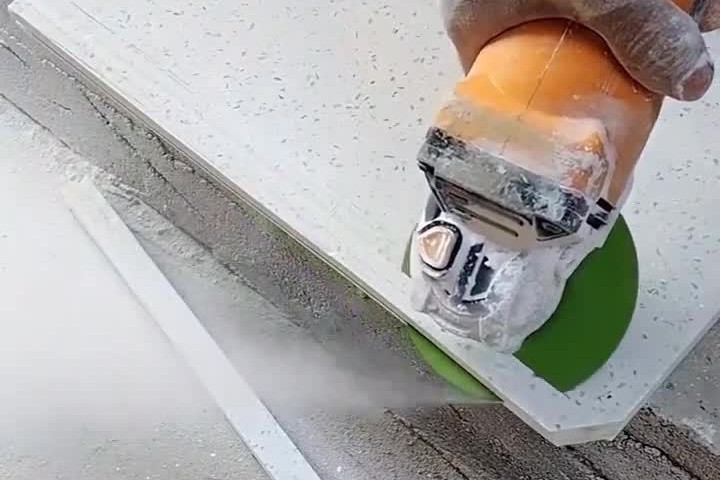
Are diamond cutting blades suitable for cutting tiles?
Introduction to Diamond Cutting Discs
Diamond cutting bladesare specialized cutting tools that incorporate diamond particles into their structure. Diamond is the hardest known natural material, and its unique properties allow these blades to effectively cut through a variety of hard materials. Here’s a detailed look at their features, applications, and benefits:
Features
1. Ingredients: Diamond cutting blades are usually made of a metal core and a tip containing diamond particles. Diamond tips are bonded to the core for efficient cutting.
2. Multiple designs: Available in a variety of designs, including segmented, continuous rim, and turbine blades, each designed to suit different cutting applications.
3. Cooling mechanism: Many blades are designed with cooling slots or holes to dissipate heat during the cutting process, which helps maintain the integrity and performance of the blade.
Application
1. Construction: Used for cutting concrete, asphalt, and masonry materials in construction and demolition projects. Ideal for creating expansion joints, cutting boards, and trimming edges.
2. Stone processing: Essential in the stone industry for cutting granite, marble, and other natural stones into slabs and tiles.
3. Metal cutting: Certain diamond blades are designed to cut steel and other metals, making them useful in metalworking applications.
4. Road construction: Works in road construction and maintenance, cutting asphalt and concrete pavements.
5. Tiles and ceramics: For precise cutting of ceramic tile, porcelain, and other hard surfaces in floor and wall applications.
6. Glass cutting: Specialized diamond blades can cut glass and other brittle materials without cracking or chipping.
Are Diamond Cutting Discs Suitable for Cutting Ceramic Tiles?
Diamond-cutting blades are known for their ability to cut through a variety of hard materials, including concrete, stone, and metal. However, special care must be taken when cutting tiles, which are often more fragile, to avoid damage.
1. Understand tile fragility
Ceramic tiles, especially ceramic and porcelain varieties, can be brittle. While diamond cutting blades are very effective for cutting hard materials, improper use can cause cracks or chipping in your tiles. Therefore, it is crucial that tile cutting is done carefully and accurately.
2. Choose the right diamond cutting blade
Blade selection
Different types of tiles have different hardness levels, requiring the selection of a suitable diamond cutting blade:
Normal tile: For standard tiles, a regular diamond cutting blade is usually sufficient.
High-hardness ceramic tiles: For harder ceramic tiles, such as glazed tiles or porcelain tiles, a more wear-resistant and harder diamond cutting blade must be selected. These blades are designed to be tough without causing damage.
3. Control cutting speed
Speed management
When cutting ceramic tiles, controlling cutting speed is crucial to prevent overheating, which can cause cracks:
Optimum speed: Slower cutting speeds are generally recommended to minimize heat generation. However, cutting too slowly can also cause problems, so finding a balance is key.
Apply pressure: Avoid applying excessive pressure when cutting. Let the blade do the work to ensure a clean cut without stressing the tile.
4. Use a water cooling system
Benefits of water cooling
Using a water cooling system during the cutting process can significantly improve results:
Temperature control: Water helps dissipate heat, reducing the risk of thermal shock that can cause tiles to crack.
Surface smoothing: Water also helps clean the cutting surface, making it smoother and reducing dust.
Execution
When using a water cooling system, make sure the water is sprayed directly onto the cutting area. Not only does this cool the blades and tiles, but it also helps keep your workspace clean.

Advantages and Disadvantages of Using Diamond Cutting Discs to Cut Ceramic Tiles
Diamond cutting blades are widely recognized for their effectiveness in cutting a variety of materials, including ceramic tiles. While they offer many benefits, there are also some drawbacks to consider.
Advantages of using diamond cutting discs
1. Fast cutting speed and high efficiency
One of the most significant advantages of diamond cutting blades is their ability to cut quickly and efficiently. The hardness of diamonds allows these blades to cut tiles with minimal resistance, making the cutting process faster compared to traditional blades. This efficiency is especially beneficial for larger projects where time is a critical factor.
2. Smooth cutting surface, no burrs and chips
Diamond cutting blades produce clean, smooth cuts, which is crucial when cutting ceramic tile. Unlike other cutting methods that may leave burrs or chips, diamond blades ensure a polished surface. This quality is especially important for aesthetic applications such as floor and wall tiles where appearance is important.
3. High cutting accuracy and accurate cutting size
Precision is crucial for tile installation, and diamond cutting discs excel in this area. They provide high cutting accuracy for precise sizes and shapes. This precision helps reduce waste and ensures the tiles fit together seamlessly, improving the overall quality of the installation.
4. Long service life
Diamond cutting blades are known for their durability and long service life. Unlike traditional blades, which can dull quickly, diamond blades stay sharp for longer, resulting in fewer replacements and lower long-term costs. This long lifespan makes them a cost-effective choice for professionals and DIY enthusiasts.
Disadvantages of using diamond cutting discs
1. The effectiveness of some tiles is reduced
While diamond cutting blades are versatile, their effectiveness may vary depending on the type of tile being cut. For example, some specialty tiles may require specific cutting tools designed for their unique properties. In this case, using a diamond saw blade may not produce optimal results, resulting in potential damage or poor cutting results.
2. Variable pricing for diamond cutting blades
The cost of diamond cutting blades can vary greatly depending on quality, brand, and specific features. While some blades are affordable, high-quality blades can be quite expensive. This price change may be a consideration for the budget-conscious consumer or contractor who needs to purchase multiple blades for different projects.
3. Additional equipment and cost of water cooling system
Using a water cooling system during the tile cutting process can improve performance and protect tiles from heat damage. However, this requires additional equipment and water sources, which increases the overall cost of the cutting process. For some users, the need for a water cooling system may be seen as an inconvenience or additional expense.
Conclusion
Diamond cutting blades can be used to cut tiles, but some tips and precautions need to be taken to avoid problems such as tile breakage. Choosing a suitable diamond cutting blade, controlling the cutting speed, and using a water cooling system can effectively protect the tiles and achieve a certain cutting effect and accuracy.
-
Online service
-
Official wechat
account
-
QQ:40933769
-
E-mail:
sales@z-lion.com
Online service
Please feel free to give your inquiry in the form below. We will reply you in 24 hours.

